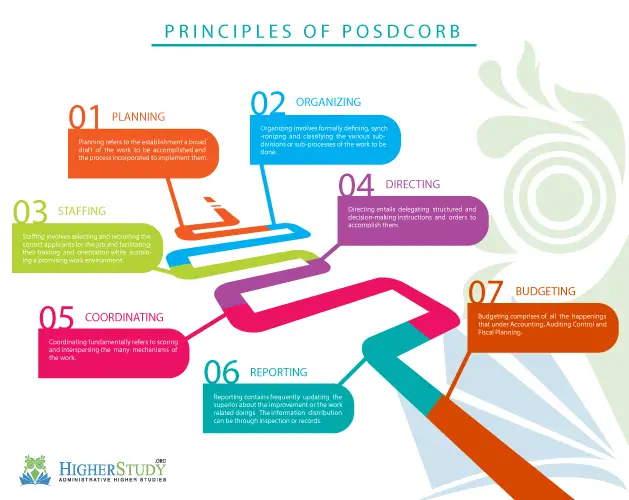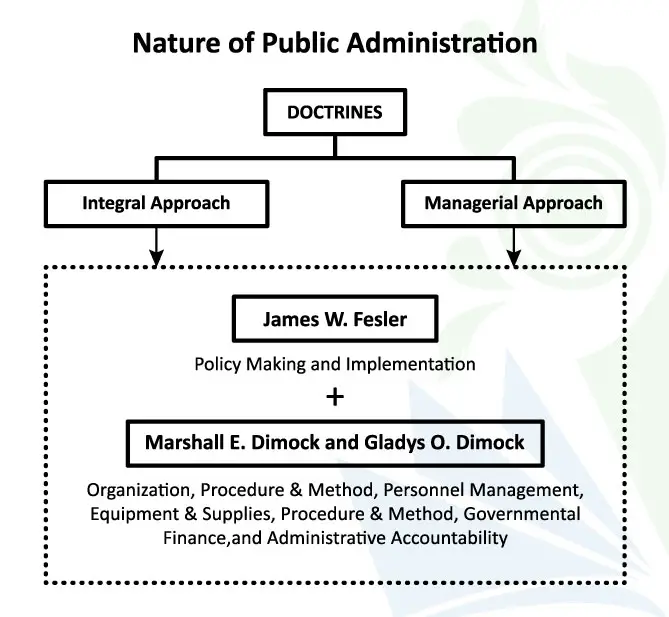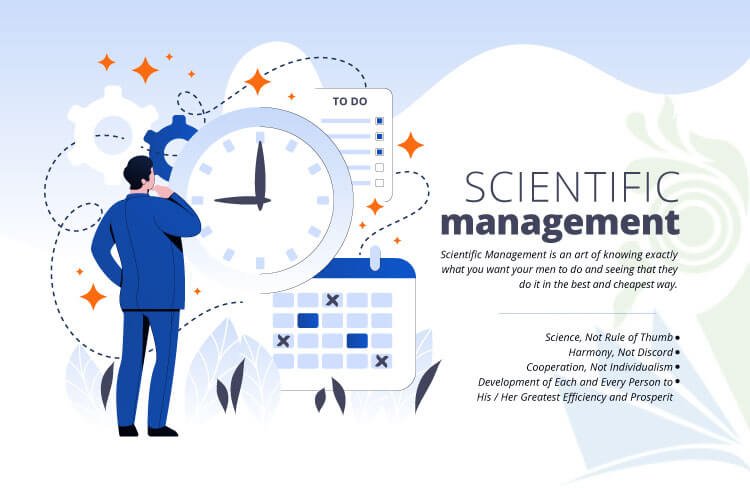POSDCORB Model, 7 Steps, Functions, Strength, Criticisms
What is POSDCORB? It's 7 Steps & Functions, Importance, Strength, Criticisms with Examples.
In Public Administration and Management, POSDCORB broadly uses it as the classical view of Organizational theory. It appeared most conspicuously in a 1937 paper by Luther Gulick and Lyndall Urwick. However, he first showed the concept in 1935. Primarily, it is proposed in an exertion to develop public service professionals.
Table of Contents
What is POSDCORB’s Definition and Meaning?
What are the basic functions of management? A memo was prepared while he was a member of the Brownlow Committee, in his piece “Notes on the Theory of Organization.” Luther Gulick asked verbally, “What is the work of the chief executive? and What does he do?” POSDCORB is the answer to these questions, for example, “considered to call devotion to the numerous functional elements of a chief executive’s work because ‘management’ and ‘administration’ have lost all exact content.” For instance, according to Gulick, the elements are:
POSDCORB Stands for
P = Planning
O = Organizing
S = Staffing
D = Directing
CO = Co-ordinating
R = Reporting
B = Budgeting
Historical Background of the POSDCORB Model
- This model is widely utilized in the field of public administration and organization as the standard correlated with organizational theory.
- Lyndall Urwick and Luther Gulick devised and revealed the model in the 1930s.
- They released it in 1937 as part of their ‘Papers on the Science of Administration.’
- POSDCORB was first presented as part of a plan to enhance public procurement authority.
- In consonance with them, the model is used by all businesses.
- POSDCORB has been widely used and most clearly expressed in the administration and management of a variety of businesses, and it is still relevant after more than four decades.
7 Steps of POSDCORB:
This really refers to the many steps or phases involved in a distinctive administrative process. It can elucidate in detail. Such as:
- Planning: Planning refers to the establishment of a broad draft of the work. It is to accomplish and the process incorporated to implement them.
- Organizing: Organizing involves formally defining, synchronizing, and classifying the various subdivisions or sub-processes of the work.
- Staffing: Staffing involves selecting and recruiting the correct applicants for the job. And facilitates their training and orientation while sustaining a promising work environment.
- Directing: Directing entails delegating structured and decision-making instructions and orders to accomplish them.
- Coordinating: Coordinating fundamentally refers to scoring and interspersing the many mechanisms of the work.
- Reporting: Reporting contains frequently updating the superior about the improvement or the work-related doings. The information distribution can be through inspection or records.
- Budgeting: Budgeting comprises all the happenings under Accounting, Auditing Control, and Fiscal Planning.
We already know how many steps or principles POSDCORB has, and what they are. Now let’s try to analyze some of the 7 steps or features of POSDCORB. Such as
1. Planning (P):
The letter P denotes the plan. Planning is the process of making a well-thought-out decision about the purpose of a task, and the process or procedures to be followed. A plan seeks answers to a few questions. Since no organization can move in the right direction without a plan, a plan is essential for performance. There are different levels of planning. Such as decision-making, determination of objectives, adoption of policies, formulation, and promotion of programs, setting of specific procedures, and setting of rules and daily programs.
2. Organizing (O):
The letter O refers to the organization. Organization means the division of labor through the hierarchical structure of authority, the coordination of assigned functions, and above all the achievement of specific goals. Dividing a whole work into different administrative divisions or units through authority. The relationship of the executive with the employees working in each administrative unit and department is also determined by the organization.
3. Staffing (S):
The letter S refers to the staffing or the management of the administrative organization. Employees are recruited for administrative management, training is provided and a favorable environment is created while improving their working conditions. In other words, the issues under staff management are recruitment, training programs, salary allowance, promotion, retirement, pension, etc.
4. Directing (D):
The letter D stands for Directing. Direction is the process of reaching a decision where orders are given and instructions are given to the employees to manage the work. The job of the chief executive is to give instructions. Subordinate employees are often unable to function properly unless instructed to do so by the CEO (Chief Executive Officer).
5. Coordination (CO):
Coordination is denoted by the letter CO. Coordination refers to the integration of different parts of interconnected work. By dividing a task into different branches on the basis of efficiency, it becomes possible to achieve a single objective. Again the work cannot become a complete unit without the coordination of the work performed by different branches or divisions. Coordination serves as the focal point of an organization.
6. Reporting (R):
The letter R denotes the reporting. The reporting is said to inform the officers of the organization about how the administrative organization is being conducted in writing to the superior executive from time to time or regularly. The report is prepared by collecting various types of information and news. By examining such reports, the senior executives can know about the activities of the subordinate officers and all the activities of the organization.
7. Budgeting (B):
The letter B refers to the budgeting. Budgeting basically refers to the system of accounting and controlling economic income and expenditure. From which sources the revenue will be collected and in which sectors the expenditure will be incurred? This is the main issue in determining the income and expenditure of the organization. The economic picture of the organization emerges through the budget.
| Content | Initial | Thought |
|---|---|---|
| Planning | P | Process of thinking |
| Organizing | O | Establishment of effective authority |
| Staffing | S | Process of hiring eligible candidates |
| Directing | D | The technique of instructing, guiding, inspiring, counseling, guiding, overseeing, inspiring, and leading people |
| Coordination | CO | Ability to use different parts of the body together efficiently and smoothly. |
Criticisms:
In early 1938, the scholar began giving the impression in the field of Public Administration, thought-provoking the legitimacy of POSDCORB. The notion is that there could even be an inflexible set of principles in administration. Protuberant Public Administration scholars such as Herbert Alexander Simon, Robert Dahl, and Dwight Waldo. They published articles and books criticizing and the concept of the principle in 1946 & 1947. Among other criticisms, Herbert Alexander Simon states that its values are a simplification of administration. Herbert Alexander Simon’s criticisms mostly center around the unity of command and span of control. Stating that every so often, a subordinate must take directives or guidance from more than one cause, as well as Luther Gulick’s specialization concepts. Other disapprovals of Simon intricate that there was a lack of indication for the POSDCORB. Yet others claim that organizations are full of diversity and are thought-provoking to control.
Strength of POSDCORB:
It usually suits the Classical Management movement, categorizing it as a component of scientific management. The principles were instrumental in emphasizing the theory of span of control. Or These were restrictions on the number of people one administrator could administrate, in addition to the unity of command on the grounds of public administration and management.
The advantages of POSDCORB or its strengths; are also called the 14 principles of management. These principles are provided by Henry Fayol who is a father of administrative management. Such as:
- Division of Work
- Authority and Responsibility
- Discipline
- Unity of Command
- Unity of Direction
- Subordination of Individual Interest to General Interest
- Remuneration of Personnel
- Centralization
- Scalar Chain
- Order
- Equity
- Stability of Tenure of Personnel
- Initiative
- Esprit de Corps
What Is the Importance of POSDCORB?
Every single business desires to have a methodical framework for confirming. There is extreme output, least expenditure, and higher boundaries. It is a technique in management that staff and personnel can accomplish in a way. It would be advantageous for a business. This notion benefits organizations by breaking down the effort into numerous procedures and supporting supreme value to each staff. These phases and steps of these principles support the Human Resource team to deliver a business’s desires.
Luther Gulick’s POSDCORB doctrine claims to play a significant role in various areas of administrative organization and management. The following are significant aspects of this doctrine. Such as-
- The purpose of this doctrine is to give practical form to the principles of administrative theory in the system of administration.
- The goal of this doctrine is to try to explain and analyze the role of executives more clearly.
- The main purpose of this doctrine is to get involved in how the structure of the organization can be further streamlined.
- As a result of this doctrine, all the work of the administrative organization can be done smoothly.
- This makes it easier for staff to demonstrate greater support for line activities.
Link: Principles of New Public Management
Example of POSDCORB Advantages and Disadvantages
Contemplate a multinational opening and exercise concerning a decent staff in the staff. As per POSDCORB in educational management, the planning phase would be doing a thorough investigation of the number of individuals needed, work type, team size, etc. Staffing and organizing phases would be the Human Resources Management department. These create a list of individuals, i.e., superintendents and minions, who would execute this role. Once this is completed, as per these principles guidance would be giving directions and warranting the strategy’s implementation as per the obligation. To safeguard and improve two-way communication, managing plays a prime role. On one occasion, all this was completed, and the different ways of reporting do, which confirmed the team’s responsibility and accountability. Lastly, the budget to be distributed is considered. In this manner, it can use for good management.
Link: Modern Paradigms of Public Administration
However, this accomplishes the explanation of POSDCORB functions along with its outline. In his 2016 portion, consultant Paul Chalekian recommended an experiential suggestion concerning the acceptance of establishments and element support.
There are some references to enrich the knowledge of the topic. You should read these books when you want to make yourself a beneficiary of this topic. The books are Papers on the Science of Administration (Early Sociology of Management and Organizations; Introducing Public Administration; Public Administration: Concepts and Cases; Classics of Public Administration; and Politics of the Administrative Process. If you are a student, these books help you to make an effective assignment easily for winning case study analysis or anything else.
People Also Ask
Below are attached some relevant and important questions and their answers. So that the content becomes easier to understand.
What is POSDCORB and its Functions?
It is the basic responsibility of a public manager. It contains seven key functions of management POSDCORB. Such as planning. organizing, staffing, directing, coordinating, reporting, and budgeting.
Who introduced POSDCORB?
Luther Gulick; full name is Luther Halsey Gulick. He is an American political or social scientist. Besides, He is a Director of its Institute of Public Administration, and Eaton Professor of Municipal Science and Administration at Columbia University; especially known as a public administration contributor. He has introduced it.
What are the five elements of administration?
The answer to the question – What are the five elements of administration? Planning, staffing, organizing, controlling, and leading are the five elements of administration.
Who is the father of the POSDCORB approach?
Luther Halsey Gulick is Luther Gulick’s full name. He is a political or social scientist from the United States. He is also the Director of Columbia University’s Institute of Public Administration and the Eaton Professor of Municipal Science and Administration; he is well-known as a public administration contributor. He’s the one who brought it up.
WHO stated POSDCORB theory?
Luther Gulick and Lyndall Urwick devised and revealed the model in the 1930s. In 1937, they published it in ‘Papers on the Science of Administration.’





POSDCORB is a set of principles of public administration. Without knowledge of POSDCORB, a student can’t understand about the public administration. Your this article carry all quality to understand properly. Thanks for sharing this amazing article to us.
Thanks for sharing this amazing article to us. I think it is the acceleration tool to learn the principles of public administration.
Without clear knowledge about the POSDCORB, a better understanding of public administration is impossible. Your this article may create easy to understand it.
Right now it seems like BlogEngine is the best blogging platform available right now. (from what I’ve read) Is that what you’re using on your blog?
WOW just what I was searching for. Came here by searching for higher study
An intriguing discussion is definitely worth comment. I do believe that you need to publish more on this topic, it may not be a taboo matter but generally, people don’t talk about such topics. To the next! Many thanks!
I really like looking through a post that can make people think. Also, many thanks for permitting me to comment!
I simply want to mention I’m beginner to blogging and site-building and definitely enjoyed this web-site. Probably I’m likely to bookmark your website . You certainly come with awesome article content. Many thanks for sharing with us your blog.
I do consider all of the ideas you’ve introduced in your post. They are very convincing and will certainly work. Still, the posts are too short for beginners. May you please lengthen them a little from subsequent time? Thanks for the post.